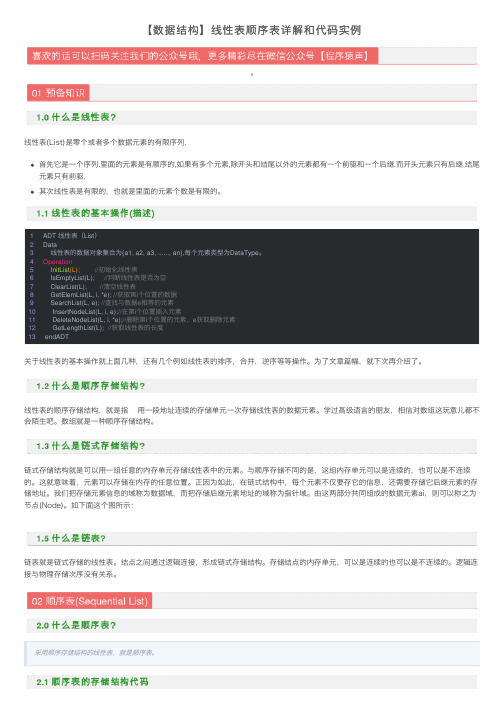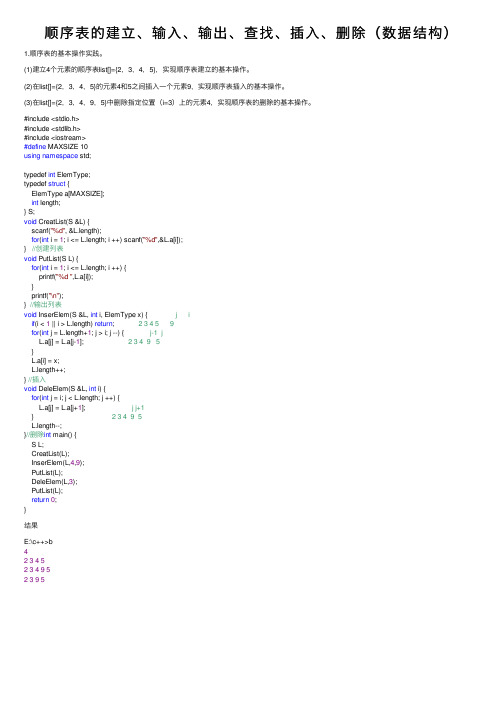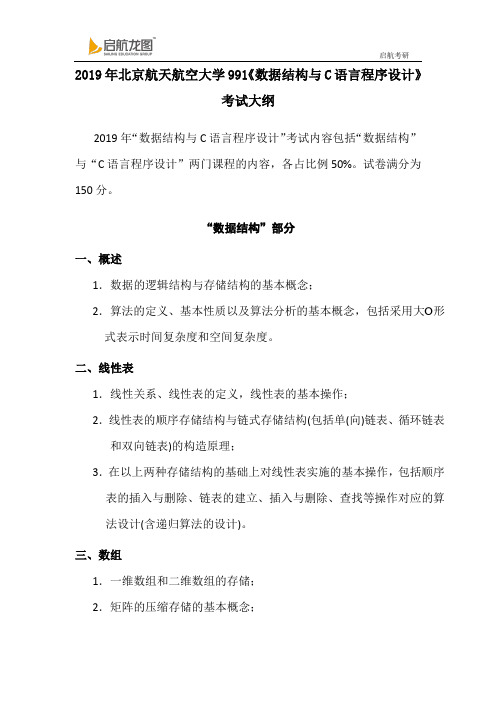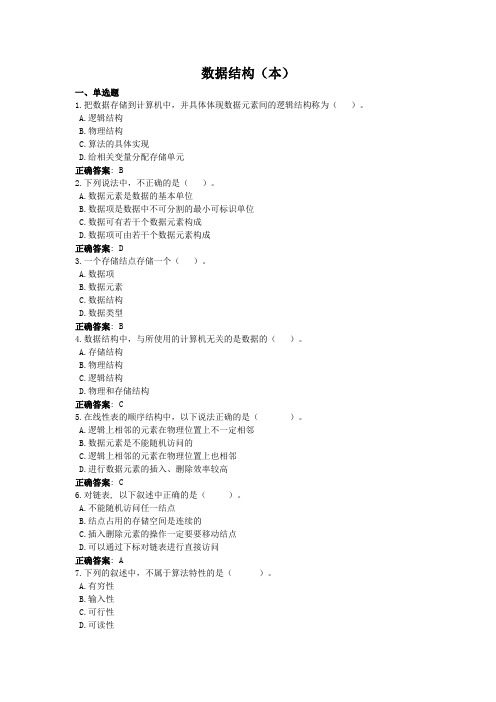数据结构顺序表的初始化,插入删除,取数据元素,查找遍历,顺序表的长度
数据结构C语言版 实验报告

数据结构C语言版实验报告一、实验目的本次实验旨在通过使用 C 语言实现常见的数据结构,加深对数据结构基本概念、原理和操作的理解,提高编程能力和解决实际问题的能力。
二、实验环境操作系统:Windows 10编程环境:Visual Studio 2019编程语言:C 语言三、实验内容1、线性表顺序表的实现与操作链表的实现与操作2、栈和队列栈的实现与应用(表达式求值)队列的实现与应用(模拟排队)3、树和二叉树二叉树的遍历(前序、中序、后序)二叉搜索树的实现与操作4、图图的存储结构(邻接矩阵、邻接表)图的遍历(深度优先搜索、广度优先搜索)四、实验步骤及结果1、线性表顺序表的实现与操作定义顺序表的数据结构,包括数组和表的长度。
实现顺序表的初始化、插入、删除、查找等操作。
测试顺序表的各种操作,输出操作结果。
```cinclude <stdioh>include <stdlibh>define MAX_SIZE 100typedef struct {int dataMAX_SIZE;int length;} SeqList;//初始化顺序表void initList(SeqList L) {L>length = 0;}//插入元素到顺序表int insertList(SeqList L, int pos, int element) {if (L>length >= MAX_SIZE || pos < 0 || pos > L>length) {return 0;}for (int i = L>length 1; i >= pos; i) {L>datai + 1 = L>datai;}L>datapos = element;L>length++;return 1;}//删除顺序表中的元素int deleteList(SeqList L, int pos) {if (pos < 0 || pos >= L>length) {return 0;}for (int i = pos; i < L>length 1; i++){L>datai = L>datai + 1;}L>length;return 1;}//查找顺序表中的元素int searchList(SeqList L, int element) {for (int i = 0; i < Llength; i++){if (Ldatai == element) {return i;}}return -1;}int main(){SeqList L;initList(&L);insertList(&L, 0, 10);insertList(&L, 1, 20);insertList(&L, 2, 30);printf("顺序表元素: ");for (int i = 0; i < Llength; i++){printf("%d ", Ldatai);}printf("\n");int pos = searchList(L, 20);if (pos!=-1) {printf("元素 20 在顺序表中的位置: %d\n", pos);} else {printf("顺序表中未找到元素 20\n");}deleteList(&L, 1);printf("删除元素后的顺序表元素: ");for (int i = 0; i < Llength; i++){printf("%d ", Ldatai);}printf("\n");return 0;}```实验结果:成功实现顺序表的初始化、插入、删除、查找等操作,输出结果符合预期。
408数据结构有几道算法题

408数据结构有几道算法题引言408数据结构是国内计算机专业考试中的一个重要科目,它涵盖了计算机科学中的数据结构相关知识和算法。
在408数据结构考试中,通常会涉及到一定数量的算法题,考察学生对数据结构的理解和应用能力。
本文将介绍408数据结构考试中常见的算法题目类型,并提供一些解题思路和示例代码。
线性表线性表是最基本的数据结构之一,它包括顺序表和链表两种实现方式。
顺序表顺序表是一种使用连续存储空间存储元素的线性表。
在408数据结构考试中,关于顺序表的算法题通常包括以下内容:1.初始化顺序表:创建一个空的顺序表,并指定其最大容量。
2.插入元素:向顺序表中指定位置插入一个元素。
3.删除元素:从顺序表中删除指定位置的元素。
4.查找元素:在顺序表中查找指定值的元素,并返回其位置。
以下是一个简单的示例代码:class SeqList:def __init__(self, max_size):self.data = [None] * max_sizeself.length = 0def insert(self, index, value):if index < 0 or index > self.length:raise IndexError("Index out of range")if self.length == len(self.data):raise ValueError("List is full")for i in range(self.length, index, -1):self.data[i] = self.data[i-1]self.data[index] = valueself.length += 1def delete(self, index):if index < 0 or index >= self.length:raise IndexError("Index out of range")for i in range(index, self.length-1):self.data[i] = self.data[i+1]self.length -= 1def search(self, value):for i in range(self.length):if self.data[i] == value:return ireturn -1链表链表是一种使用非连续存储空间存储元素的线性表。
codeblock数据结构算法实现-顺序表基本操作

数据结构算法实现-顺序表基本操作序号一、引言二、顺序表的定义三、顺序表的基本操作1.初始化操作2.插入操作3.删除操作4.查找操作四、顺序表的实现五、总结一、引言数据结构是计算机科学中非常重要的一部分,它是计算机存储、组织数据的方式。
而顺序表是其中的一种基本数据结构,它采用一组位置区域连续的存储单元依次存放线性表中的元素。
本文将着重介绍顺序表的基本操作及其算法实现。
二、顺序表的定义顺序表是一种基本的线性表,顺序表中元素的逻辑顺序和物理顺序是一致的。
顺序表的特点是利用一组连续的存储单元依次存放线性表中的元素。
顺序表可以用数组实现,其元素在内存中是连续存储的,可以通过下标直接访问元素。
由于顺序表的存储方式,使得其在查找、插入和删除等操作上具有较好的性能。
三、顺序表的基本操作顺序表的基本操作包括初始化、插入、删除和查找等。
下面分别介绍这些操作的实现方法。
1.初始化操作初始化操作是指将一个空的顺序表初始化为一个具有初始容量的顺序表,并为其分配内存空间。
初始化操作的实现方法主要有两种,一种是静态分配内存空间,另一种是动态分配内存空间。
静态分配内存空间时,需要预先指定顺序表的容量大小,然后在程序中创建一个数组,并为其分配指定大小的内存空间。
动态分配内存空间时,可以根据需要动态创建一个数组,并为其分配内存空间。
下面是一个简单的初始化操作的实现示例:```C代码#define MAXSIZE 100 // 定义顺序表的最大容量typedef struct {ElementType data[MAXSIZE]; // 定义顺序表的元素数组int length; // 定义顺序表的当前长度} SeqList;2.插入操作插入操作是指将一个新元素插入到顺序表的指定位置。
插入操作的实现方法主要包括在指定位置插入元素,同时对其他元素进行后移操作。
下面是一个简单的插入操作的实现示例:```C代码Status Insert(SeqList *L, int i, ElementType e) {if (i < 1 || i > L->length + 1) { // 判断插入位置是否合法return ERROR;}if (L->length >= MAXSIZE) { // 判断顺序表是否已满return ERROR;}for (int j = L->length; j >= i; j--) { // 插入位置及之后的元素后移L->data[j] = L->data[j - 1];}L->data[i - 1] = e; // 插入新元素L->length++; // 顺序表长度加1return OK;}```3.删除操作删除操作是指将顺序表中指定位置的元素删除。
数据结构期末复习总结

第1章绪论1.数据(Data) :是描述客观事物的数字、字符以及所有能输入到计算机中并能被计算机接受的各种符号集合的统称。
包括数值数据和非数值数据(字符串、图形、图像、音频、视频)。
2.数据元素(Data Element) :表示一个事物的一组数据称为一个数据元素(结点顶点、记录);数据元素是数据的基本单位。
3.数据项(Data Item):是数据元素中有独立含义的、不可分割的最小标识单位(字段、域、属性)。
一个数据元素可由若干个数据项组成。
4.数据对象(Data Object):是性质相同的数据元素的集合,是数据的一个子集。
如字符集合C ={A,B,C,…} 。
数据(Data) :是描述客观事物的数字、字符以及所有能输入到计算机中并能被计算机接受的各种符号集合的统称。
包括数值数据和非数值数据(字符串、图形、图像、音频、视频)。
数据元素(Data Element) :表示一个事物的一组数据称为一个数据元素(结点、顶点、记录);数据元素是数据的基本单位。
数据项(Data Item):是数据元素中有独立含义的、不可分割的最小标识单位(字段、域、属性)。
一个数据元素可由若干个数据项组成。
数据对象(Data Object):是性质相同的数据元素的集合,是数据的一个子集。
如字符集合C ={A,B,C,…} 。
●数据的逻辑结构指数据元素之间的逻辑关系,用一个数据元素的集合和定义在此集合上的若干关系来表示。
●四种逻辑结构:集合、线性结构、树型结构、图状结构。
●数据结构的形式定义是一个二元组:Data-Structure=(D,S)其中:D是数据元素的有限集,S是D上关系的有限集。
例1:设数据逻辑结构B=(K,R)K={k1, k2, …, k9}R={ <k1, k3>,<k1, k8>,<k2, k3>,<k2, k4>,<k2, k5>,<k3, k9>,<k5, k6>,<k8, k9>,<k9, k7>,<k4, k7>,<k4, k6>有时候关系图不唯一(一般是无向图)●数据结构在计算机内存中的存储包括数据元素的存储和元素之间的关系的表示。
数据结构中顺序表的基本操作

数据结构中顺序表的基本操作
顺序表是一种线性表的存储结构,使用一组连续的存储单元来存储元素,其基本操作包括:
1. 初始化:创建一个空顺序表,设置其长度为0。
2. 插入元素:在顺序表的指定位置插入一个元素,需要将插入位置之后的元素依次向后移动,然后将新元素放入插入位置,并更新顺序表的长度。
3. 删除元素:删除顺序表中的指定位置的元素,需要将删除位置之后的元素依次向前移动,然后更新顺序表的长度。
4. 查找元素:根据元素的值,查找顺序表中第一个与该值相等的元素,并返回其位置。
如果不存在,则返回-1。
5. 获取元素:根据位置,返回顺序表中指定位置的元素。
6. 修改元素:根据位置,修改顺序表中指定位置的元素。
7. 清空顺序表:将顺序表的长度设置为0,即清空元素。
这些基本操作可以根据具体需求进行使用和扩展。
数据结构的实验报告

一、实验目的本次实验旨在让学生掌握数据结构的基本概念、逻辑结构、存储结构以及各种基本操作,并通过实际编程操作,加深对数据结构理论知识的理解,提高编程能力和算法设计能力。
二、实验内容1. 线性表(1)顺序表1)初始化顺序表2)向顺序表插入元素3)从顺序表删除元素4)查找顺序表中的元素5)顺序表的逆序操作(2)链表1)创建链表2)在链表中插入元素3)在链表中删除元素4)查找链表中的元素5)链表的逆序操作2. 栈与队列(1)栈1)栈的初始化2)入栈操作3)出栈操作4)获取栈顶元素5)判断栈是否为空(2)队列1)队列的初始化2)入队操作3)出队操作4)获取队首元素5)判断队列是否为空3. 树与图(1)二叉树1)创建二叉树2)遍历二叉树(前序、中序、后序)3)求二叉树的深度4)求二叉树的宽度5)二叉树的镜像(2)图1)创建图2)图的深度优先遍历3)图的广度优先遍历4)最小生成树5)最短路径三、实验过程1. 线性表(1)顺序表1)初始化顺序表:创建一个长度为10的顺序表,初始化为空。
2)向顺序表插入元素:在顺序表的第i个位置插入元素x。
3)从顺序表删除元素:从顺序表中删除第i个位置的元素。
4)查找顺序表中的元素:在顺序表中查找元素x。
5)顺序表的逆序操作:将顺序表中的元素逆序排列。
(2)链表1)创建链表:创建一个带头结点的循环链表。
2)在链表中插入元素:在链表的第i个位置插入元素x。
3)在链表中删除元素:从链表中删除第i个位置的元素。
4)查找链表中的元素:在链表中查找元素x。
5)链表的逆序操作:将链表中的元素逆序排列。
2. 栈与队列(1)栈1)栈的初始化:创建一个栈,初始化为空。
2)入栈操作:将元素x压入栈中。
3)出栈操作:从栈中弹出元素。
4)获取栈顶元素:获取栈顶元素。
5)判断栈是否为空:判断栈是否为空。
(2)队列1)队列的初始化:创建一个队列,初始化为空。
2)入队操作:将元素x入队。
3)出队操作:从队列中出队元素。
数据结构-顺序表-实验报告

实验报告课程数据结构及算法实验项目 1.顺序表的建立和基本运算成绩专业班级*** 指导教师***姓名*** 学号*** 实验日期***实验一顺序表的建立和基本运算一、实验目的1、掌握顺序表存储结构的定义及C/C++语言实现2、掌握顺序表的各种基本操作及C/C++语言实现3、设计并实现有序表的遍历、插入、删除等常规算法二、实验环境PC微机,Windows,DOS,Turbo C或者Visual C++三、实验内容1、顺序表的建立和基本运算(1)问题描述顺序表时常进行的运算包括:创建顺序表、销毁顺序表、求顺序表的长度、在顺序表中查找某个数据元素、在某个位置插入一个新数据元素、在顺序表中删除某个数据元素等操作。
试编程实现顺序表的这些基本运算。
(2)基本要求实现顺序表的每一个运算要求用一个函数实现。
(3)算法描述参见教材算法2.3、算法2.4、算法2.5等顺序表的常规算法。
(4)算法实现#include<malloc.h> // malloc()等#include<stdio.h> // NULL, printf()等#include<process.h> // exit()// 函数结果状态代码#define OVERFLOW -2#define TRUE 1#define FALSE 0#define OK 1#define ERROR 0#define INFEASIBLE -1typedef int Status; // Status是函数的类型,其值是函数结果状态代码,如OK等typedef int Boolean; // Boolean是布尔类型,其值是TRUE或者FALSE//-------- 线性表的动态分配顺序存储结构-----------#define LIST_INIT_SIZE 10 // 线性表存储空间的初始分配量#define LIST_INCREMENT 2 // 线性表存储空间的分配增量typedef int ElemType;struct SqList{ElemType *elem; // 存储空间基址int length; // 当前长度int listsize; // 当前分配的存储容量(以sizeof(int)为单位)};void InitList(SqList &L) // 算法2.3{ // 操作结果:构造一个空的顺序线性表LL.elem=new ElemType[LIST_INIT_SIZE];if(!L.elem)exit(OVERFLOW); // 存储分配失败L.length=0; // 空表长度为0L.listsize=LIST_INIT_SIZE; // 初始存储容量}void DestroyList(SqList &L){ // 初始条件:顺序线性表L已存在。
2024年基础数据总结(2篇)

2024年基础数据总结____年是一个充满挑战和机遇的一年。
全球各国都在努力应对面临的各种问题,包括经济发展、环境保护和社会稳定等方面。
本文将从各个方面总结____年的基础数据。
经济发展方面,____年全球经济继续保持稳定增长。
预计全球GDP增速为3.5%,略低于去年的4%。
亚洲地区仍然是全球经济增长的引擎,其中中国和印度的经济增长率超过了全球平均水平。
美国经济增长势头放缓,但仍然保持在2%左右的水平。
在中国,经济发展仍然保持稳定。
据统计,____年中国国内生产总值增长率为6.2%,略低于去年的6.6%。
这主要是由于国内外经济环境的不确定性导致投资和消费增长放缓。
然而,中国政府积极推动结构性改革和创新发展,使得经济转型和升级取得了明显进展。
消费和服务业成为经济增长的重要动力,对整体经济的贡献逐渐增加。
环境保护方面,____年全球各国继续加强环境保护措施。
为了应对气候变化和减少碳排放,各国加大了清洁能源投资和绿色技术研发。
全球可再生能源占比逐渐增加,____年的可再生能源消费量增长了15%。
同时,各国也加强了对自然资源的保护和管理,特别是对森林、水资源和海洋生态系统的保护。
社会稳定方面,____年全球社会稳定局势总体上保持了相对平和。
然而,仍然存在一些社会问题需要解决,如贫富差距扩大、教育资源不平等等。
各国政府采取了措施来促进社会公平和和谐发展,包括改善社会福利制度、加大教育投资和就业机会的创造等。
科技和创新方面,____年是一个创新的时代。
全球各国在科技研发和应用方面取得了巨大进展。
人工智能、物联网、大数据和区块链等新兴技术得到广泛应用,为经济增长和社会发展带来新机遇。
同时,各国政府也加大了对科技创新的支持力度,鼓励和培育创新企业和创新人才。
教育方面,____年全球教育事业继续发展。
各国政府加大了对教育投资的力度,提高了教育资源的公平分配。
在线教育与传统教育相结合,成为教育发展的新趋势。
同时,STEM教育(科学、技术、工程和数学)也受到广泛关注,各国将STEM教育作为培养创新人才的重要手段。
数据结构课程设计-学生-21个题目

选题一:迷宫与栈问题【问题描述】以一个mXn的长方阵表示迷宫,0和1分别表示迷宫中的通路和障碍。
设计一个程序,对任意设定的迷宫,求出一条从入口到出口的通路,或得出没有通路的结论。
【任务要求】1)首先实现一个以链表作存储结构的栈类型,然后编写一个求解迷宫的非递归程序。
求得的通路以三元组(i,j,d)的形式输出。
其中:(i,j)指示迷宫中的一个坐标,d表示走到下一坐标的方向。
如,对于下列数据的迷宫,输出一条通路为:(1,1,1),(1,2,2),(2,2,2),(3,2,3),(3,1,2),…。
2)编写递归形式的算法,求得迷宫中所有可能的通路。
3)以方阵形式输出迷宫及其通路。
【测试数据】迷宫的测试数据如下:左上角(0,1)为入口,右下角(8,9)为出口。
出口出口选题二:算术表达式与二叉树【问题描述】一个表达式和一棵二叉树之间,存在着自然的对应关系。
写一个程序,实现基于二叉树表示的算术表达式的操作。
【任务要求】假设算术表达式Expression内可以含有变量(a~z)、常量(0~9)和二元运算符(+,-,*,/,^(乘幂))。
实现以下操作:1)ReadExpre(E)—以字符序列的形式输入语法正确的前缀表达式并构造表达式E。
2)WriteExpre(E)—用带括弧的中缀表达式输出表达式E。
3)Assign(V,c)—实现对变量V的赋值(V=c),变量的初值为0。
4)Value(E)—对算术表达式E求值。
5)CompoundExpr(P,E1,E2)--构造一个新的复合表达式(E1)P(E2)【测试数据】1)分别输入0;a;-91;+a*bc;+*5^x2*8x;+++*3^x3*2^x2x6并输出。
2)每当输入一个表达式后,对其中的变量赋值,然后对表达式求值。
选题三:银行业务模拟与离散事件模拟【问题描述】假设某银行有4个窗口对外接待客户,从早晨银行开门(开门9:00am,关门5:00pm)起不断有客户进入银行。
第3章数据结构基本类型3.1线性表-高中教学同步《信息技术-数据与数据结构》(教案)

布置预习任务,要求学生提前阅读线性表的基础知识和概念。
发放预习材料,如PPT、视频教程或预习习题。
课堂讨论引导:
准备引导性问题,鼓励学生积极参与课堂讨论。
设计小组活动,促进学生之间的合作与交流。
课后反馈:
设计课后习题和作业,以检验学生的学习效果。
准备课后答疑和辅导,为学生提供必要的帮助和支持。
确保教学环境中网络连接稳定,以便在需要时展示在线资源或示例。
教学媒体
教学媒体
PPT演示文稿:
线性表的基本概念、定义、特点和示例的幻灯片。
顺序存储和链式存储的对比图示。
线性表基本操作(如初始化、查找、插入、删除)的动画或图解。
代码编辑器/IDE:
演示顺序表和链表的实现代码(如Python)。
允许学生直接看到、理解和操作代码。
情感、态度与价值观:
激发学生的学习兴趣和创造力,培养学生的探索精神和创新精神。
引导学生认识到数据结构在解决实际问题中的重要性,形成合理的计算机思维观念。
学习重难点
教学重点
线性表的基本概念:理解线性表是什么,它如何表示具有相同பைடு நூலகம்型数据元素的有限序列,并理解其特点,包括唯一的首尾元素以及除首尾外每个元素有且仅有一个前驱和后继。
准备用于课堂讨论的实例和问题,如通信录的设计和实现。
准备教学用计算机和相关编程环境(如Python环境),以便现场演示代码和执行结果。
教学流程设计:
设计教学流程,从线性表的基础概念引入,逐步深入到线性表的存储方式和操作。
设计课堂互动环节,如提问、小组讨论等,鼓励学生积极参与和表达。
安排编程实践环节,让学生亲自编写线性表相关操作的代码,加深理解。
线性表的应用场景:通过通信录的实例,了解线性表在实际问题中的应用,并理解如何根据需求选择合适的数据结构和存储方式。
线性表实验报告

线性表实验报告一、实验目的本次实验的主要目的是深入理解线性表的基本概念和操作,通过实际编程实现线性表的存储和基本运算,掌握线性表在数据结构中的应用,提高对数据结构的理解和编程能力。
二、实验环境本次实验使用的编程语言为C++,开发工具为Visual Studio 2019。
三、实验原理线性表是一种最基本、最简单的数据结构,它是由 n(n≥0)个数据元素组成的有限序列。
在这个序列中,每个数据元素的位置是按照其逻辑顺序排列的。
线性表有两种存储结构:顺序存储结构和链式存储结构。
顺序存储结构是用一组地址连续的存储单元依次存储线性表中的数据元素,使得逻辑上相邻的两个元素在物理位置上也相邻。
其优点是可以随机访问表中的任意元素,时间复杂度为 O(1);缺点是插入和删除操作需要移动大量元素,时间复杂度为 O(n)。
链式存储结构是通过指针将各个数据元素链接起来,每个数据元素由数据域和指针域组成。
其优点是插入和删除操作不需要移动大量元素,时间复杂度为 O(1);缺点是不能随机访问表中的元素,需要从头指针开始遍历,时间复杂度为 O(n)。
四、实验内容本次实验实现了顺序表和链表的基本操作,包括创建、插入、删除、查找、遍历等。
1、顺序表的实现定义顺序表的结构体,包括数据存储数组和表的长度。
实现顺序表的初始化函数,将表的长度初始化为 0。
实现顺序表的插入函数,在指定位置插入元素,如果插入位置非法或表已满,则返回错误。
实现顺序表的删除函数,删除指定位置的元素,如果删除位置非法,则返回错误。
实现顺序表的查找函数,查找指定元素,如果找到则返回元素的位置,否则返回-1。
实现顺序表的遍历函数,输出表中的所有元素。
2、链表的实现定义链表的结构体,包括数据域和指向下一个节点的指针域。
实现链表的创建函数,创建一个空链表。
实现链表的插入函数,在指定位置插入元素,如果插入位置非法,则返回错误。
实现链表的删除函数,删除指定位置的元素,如果删除位置非法,则返回错误。
数据结构上机实验题

思考与提高:
1.如果按由表尾至表头的次序输入数据元素,应如何建立顺序表。
{
Datatypestack[MAXNUM];
int top;
}SqStack;
/*初始化顺序栈函数*/
void InitStack(SqStack *p)
{q=(SqStack*)malloc(sizeof(SqStack) /*申请空间*/}
/*入栈函数*/
void Push(SqStack *p,Datatypex)
实现提示:
1.由于C语言的数组类型也有随机存取的特点,一维数组的机内表示就是顺序结构。因此,可用C语言的一维数组实现线性表的顺序存储。
在此,我们利用C语言的结构体类型定义顺序表:
#define MAXSIZE 1024
typedef int elemtype; /*线性表中存放整型元素*/
typedef struct
实验一线性表
实验目的:
1.熟悉C语言的上机环境,进一步掌握C语言的结构特点。
2.掌握线性表的顺序存储结构的定义及C语言实现。
3.掌握线性表的链式存储结构——单链表的定义及C语言实现。
4.掌握线性表在顺序存储结构即顺序表中的各种基本操作。
5.掌握线性表在链式存储结构——单链表中的各种基本操作。
实验内容:
printf("输入源点v1 : ");
scanf("%d",&v1); /*输入源点V1 */
【数据结构】线性表顺序表详解和代码实例

【数据结构】线性表顺序表详解和代码实例线性表(List)是零个或者多个数据元素的有限序列.⾸先它是⼀个序列.⾥⾯的元素是有顺序的,如果有多个元素,除开头和结尾以外的元素都有⼀个前驱和⼀个后继.⽽开头元素只有后继,结尾元素只有前驱.其次线性表是有限的,也就是⾥⾯的元素个数是有限的。
1ADT 线性表(List)2Data3线性表的数据对象集合为{a1, a2, a3, ......, an},每个元素类型为DataType。
4Operation5InitList(L); //初始化线性表6 IsEmptyList(L); //判断线性表是否为空7 ClearList(L); //清空线性表8 GetElemList(L, i, *e); //获取第i个位置的数据9 SearchList(L, e); //查找与数据e相等的元素10 InsertNodeList(L, i, e);//在第i个位置插⼊元素11 DeleteNodeList(L, i, *e);//删除第i个位置的元素,e获取删除元素12 GetLengthList(L); //获取线性表的长度13endADT关于线性表的基本操作就上⾯⼏种,还有⼏个例如线性表的排序,合并,逆序等等操作。
为了⽂章篇幅,就下次再介绍了。
线性表的顺序存储结构,就是指 ⽤⼀段地址连续的存储单元⼀次存储线性表的数据元素。
学过⾼级语⾔的朋友,相信对数组这玩意⼉都不会陌⽣吧。
数组就是⼀种顺序存储结构。
链式存储结构就是可以⽤⼀组任意的内存单元存储线性表中的元素。
与顺序存储不同的是,这组内存单元可以是连续的,也可以是不连续的。
这就意味着,元素可以存储在内存的任意位置。
正因为如此,在链式结构中,每个元素不仅要存它的信息,还需要存储它后继元素的存储地址。
我们把存储元素信息的域称为数据域,⽽把存储后继元素地址的域称为指针域。
由这两部分共同组成的数据元素ai,则可以称之为节点(Node)。
数据结构实验报告-实验一顺序表、单链表基本操作的实现

数据结构实验报告-实验⼀顺序表、单链表基本操作的实现实验⼀顺序表、单链表基本操作的实现l 实验⽬的1、顺序表(1)掌握线性表的基本运算。
(2)掌握顺序存储的概念,学会对顺序存储数据结构进⾏操作。
(3)加深对顺序存储数据结构的理解,逐步培养解决实际问题的编程能⼒。
l 实验内容1、顺序表1、编写线性表基本操作函数:(1)InitList(LIST *L,int ms)初始化线性表;(2)InsertList(LIST *L,int item,int rc)向线性表的指定位置插⼊元素;(3)DeleteList1(LIST *L,int item)删除指定元素值的线性表记录;(4)DeleteList2(LIST *L,int rc)删除指定位置的线性表记录;(5)FindList(LIST *L,int item)查找线性表的元素;(6)OutputList(LIST *L)输出线性表元素;2、调⽤上述函数实现下列操作:(1)初始化线性表;(2)调⽤插⼊函数建⽴⼀个线性表;(3)在线性表中寻找指定的元素;(4)在线性表中删除指定值的元素;(5)在线性表中删除指定位置的元素;(6)遍历并输出线性表;l 实验结果1、顺序表(1)流程图(2)程序运⾏主要结果截图(3)程序源代码#include<stdio.h>#include<stdlib.h>#include<malloc.h>struct LinearList/*定义线性表结构*/{int *list; /*存线性表元素*/int size; /*存线性表长度*/int Maxsize; /*存list数组元素的个数*/};typedef struct LinearList LIST;void InitList(LIST *L,int ms)/*初始化线性表*/{if((L->list=(int*)malloc(ms*sizeof(int)))==NULL){printf("内存申请错误");exit(1);}L->size=0;L->Maxsize=ms;}int InsertList(LIST *L,int item,int rc)/*item记录值;rc插⼊位置*/ {int i;if(L->size==L->Maxsize)/*线性表已满*/return -1;if(rc<0)rc=0;if(rc>L->size)rc=L->size;for(i=L->size-1;i>=rc;i--)/*将线性表元素后移*/L->list[i+=1]=L->list[i];L->list[rc]=item;L->size++;return0;}void OutputList(LIST *L)/*输出线性表元素*/{int i;printf("%d",L->list[i]);printf("\n");}int FindList(LIST *L,int item)/*查找线性元素,返回值>=0为元素的位置,返回-1为没找到*/ {int i;for(i=0;i<L->size;i++)if(item==L->list[i])return i;return -1;}int DeleteList1(LIST *L,int item)/*删除指定元素值得线性表记录,返回值为>=0为删除成功*/ {int i,n;for(i=0;i<L->size;i++)if(item==L->list[i])break;if(i<L->size){for(n=i;n<L->size-1;n++)L->list[n]=L->list[n+1];L->size--;return i;}return -1;}int DeleteList2(LIST *L,int rc)/*删除指定位置的线性表记录*/{int i,n;if(rc<0||rc>=L->size)return -1;for(n=rc;n<L->size-1;n++)L->list[n]=L->list[n+1];L->size--;return0;}int main(){LIST LL;int i,r;printf("list addr=%p\tsize=%d\tMaxsize=%d\n",LL.list,LL.size,LL.Maxsize);printf("list addr=%p\tsize=%d\tMaxsize=%d\n",LL.list,LL.list,LL.Maxsize);while(1){printf("请输⼊元素值,输⼊0结束插⼊操作:");fflush(stdin);/*清空标准输⼊缓冲区*/scanf("%d",&i);if(i==0)break;printf("请输⼊插⼊位置:");scanf("%d",&r);InsertList(&LL,i,r-1);printf("线性表为:");OutputList(&LL);}while(1){printf("请输⼊查找元素值,输⼊0结束查找操作:");fflush(stdin);/*清空标准输⼊缓冲区*/scanf("%d ",&i);if(i==0)break;r=FindList(&LL,i);if(r<0)printf("没有找到\n");elseprintf("有符合条件的元素,位置为:%d\n",r+1);}while(1){printf("请输⼊删除元素值,输⼊0结束查找操作:");fflush(stdin);/*清楚标准缓存区*/scanf("%d",&i);if(i==0)break;r=DeleteList1(&LL,i);if(i<0)printf("没有找到\n");else{printf("有符合条件的元素,位置为:%d\n线性表为:",r+1);OutputList(&LL);}while(1){printf("请输⼊删除元素位置,输⼊0结束查找操作:");fflush(stdin);/*清楚标准输⼊缓冲区*/scanf("%d",&r);if(r==0)break;i=DeleteList2(&LL,r-1);if(i<0)printf("位置越界\n");else{printf("线性表为:");OutputList(&LL);}}}链表基本操作l 实验⽬的2、链表(1)掌握链表的概念,学会对链表进⾏操作。
数据结构课程标准

数据结构模块化课程标准课程名称:数据结构适用专业:计算机科学与技术、通信工程、信息管理与信息系统等相关专业学时/学分:64/4一、课程定位《数据结构》是研究现实世界中数据的各种逻辑结构在计算机中的存储结构以及进行各种非数值操作的方法。
通常情况下,精心选择的数据结构可以带来更高的运行或者存储效率。
数据结构往往同高效的检索算法和索引技术有关。
它不仅是计算机程序设计的理论基础,而且是学习计算机操作系统、编译原理、数据库原理等课程的重要基础。
数据结构是要培养学生分析和研究计算机加工的数据对象特征的能力,本课程定位严格服务于应用型高等学校专业人才培养目标,坚持理论与上机实践相结合,通过算法训练提高学生的编程思维与编程能力,通过程序设计的技能训练来促进学生的综合应用能力和专业素质的提高。
二、课程设计思路课程建设指导思想是:树立精品意识;渗透创新理念;体现应用型办学特色;注重实践教学。
课程安排在大学二年级第一个学期,学习数据结构的目的是为了可以更好地理解计算机处理对象的特性、将实际问题所涉及的处理对象在计算机中表示出来并对它们进行处理。
数据结构课程内容概念多、综合性和技巧性强,对于学生来说,学生难以听懂,因此,在教学方法上宜采用案例教学,实验上采用项目驱动。
课程教学要结合学校应用型人才培养的定位,培养学生的学习兴趣和良好的学习习惯,通过实践教学中以培养学生的独立思考能力、动手能力。
通过小组合作、项目带动等方式进一步培养学生的沟通能力和创新能力。
课程结束后,学生应能独立上机编写并调试程序,用程序解决实际问题。
在二年级的学习中,学生需要掌握各种逻辑结构在不同存储方式下的常用算法,能够编写课程标准中的所有实训项目。
教学方法和手段:在实际教学中,我们采取多媒体进行教学,课外让学生在慕课网注册学习,学生可根据自身的学习情况利用课外时间进行针对性的复习;根据不同的章节内容,在教学中突出重点,并根据不同的章节制订相应的授课计划。
顺序表的建立、输入、输出、查找、插入、删除(数据结构)

顺序表的建⽴、输⼊、输出、查找、插⼊、删除(数据结构)1.顺序表的基本操作实践。
(1)建⽴4个元素的顺序表list[]={2,3,4,5},实现顺序表建⽴的基本操作。
(2)在list[]={2,3,4,5}的元素4和5之间插⼊⼀个元素9,实现顺序表插⼊的基本操作。
(3)在list[]={2,3,4,9,5}中删除指定位置(i=3)上的元素4,实现顺序表的删除的基本操作。
#include <stdio.h>#include <stdlib.h>#include <iostream>#define MAXSIZE 10using namespace std;typedef int ElemType;typedef struct {ElemType a[MAXSIZE];int length;} S;void CreatList(S &L) {scanf("%d", &L.length);for(int i = 1; i <= L.length; i ++) scanf("%d",&L.a[i]);} //创建列表void PutList(S L) {for(int i = 1; i <= L.length; i ++) {printf("%d ",L.a[i]);}printf("\n");} //输出列表void InserElem(S &L, int i, ElemType x) { j iif(i < 1 || i > L.length) return; 2 3 4 5 9for(int j = L.length+1; j > i; j --) { j-1jL.a[j] = L.a[j-1]; 2 3 4 9 5}L.a[i] = x;L.length++;} //插⼊void DeleElem(S &L, int i) {for(int j = i; j < L.length; j ++) {L.a[j] = L.a[j+1]; j j+1} 2 3 4 9 5L.length--;}//删除int main() {S L;CreatList(L);InserElem(L,4,9);PutList(L);DeleElem(L,3);PutList(L);return0;}结果E:\c++>b42345234952395。
2019 北京航天航空大学 991《数据结构与C语言程序设计》 考试大纲

2019年北京航天航空大学991《数据结构与C语言程序设计》考试大纲2019年“数据结构与C语言程序设计”考试内容包括“数据结构”与“C语言程序设计”两门课程的内容,各占比例50%。
试卷满分为150分。
“数据结构”部分一、概述1.数据的逻辑结构与存储结构的基本概念;2.算法的定义、基本性质以及算法分析的基本概念,包括采用大 形式表示时间复杂度和空间复杂度。
二、线性表1.线性关系、线性表的定义,线性表的基本操作;2.线性表的顺序存储结构与链式存储结构(包括单(向)链表、循环链表和双向链表)的构造原理;3.在以上两种存储结构的基础上对线性表实施的基本操作,包括顺序表的插入与删除、链表的建立、插入与删除、查找等操作对应的算法设计(含递归算法的设计)。
三、数组1.一维数组和二维数组的存储;2.矩阵的压缩存储的基本概念;3.对称矩阵、对角矩阵以及三角矩阵的压缩存储。
四、堆栈与队列1.堆栈与队列的基本概念与基本操作;2.堆栈与队列的顺序存储结构与链式存储结构的构造原理;3.在不同存储结构的基础上对堆栈与队列实施插入与删除等基本操作的算法设计;4.堆栈和队列在解决实际问题中应用。
五、树与二叉树1.树与二叉树的基本概念,基本特征、名词术语;2.完全二叉树与满二叉树的基本概念,二叉树的基本性质及其应用;3.二叉树的顺序存储结构与二叉链表存储结的基本原理;4.二叉树的前序遍历、中序遍历、后序遍历和按层次遍历,重点是二叉树在以二叉链表作为存储结构基础上各种遍历算法(包括非递归算法)的设计与应用;5.二叉排序树的基本概念、建立(插入)、查找以及平均查找长度ASL 的计算。
六、图1.图的基本概念、名词术语;2.图的邻接矩阵存储方法和邻接表(含逆邻接表)存储方法的构造原理及特点;3.图的深度优先搜索与广度优先搜索;4.最小(代价)生成树、最短路径、AOV网与拓扑排序的基本概念。
七、文件及查找1.顺序查找法以及平均查找长度(ASL)的计算;2.折半查找法以及平均查找长度(ASL)的计算,包括查找过程对应的“判定树”的构造;3.散列(Hash)表的构造、散列函数的构造,散列冲突的基本概念、处理散列冲突的基本方法以及散列表的查找和平均查找长度的计算。
数据结构(本)-国家开放大学电大学习网形考作业题目答案

数据结构(本)一、单选题1.把数据存储到计算机中,并具体体现数据元素间的逻辑结构称为()。
A.逻辑结构B.物理结构C.算法的具体实现D.给相关变量分配存储单元正确答案: B2.下列说法中,不正确的是()。
A.数据元素是数据的基本单位B.数据项是数据中不可分割的最小可标识单位C.数据可有若干个数据元素构成D.数据项可由若干个数据元素构成正确答案: D3.一个存储结点存储一个()。
A.数据项B.数据元素C.数据结构D.数据类型正确答案: B4.数据结构中,与所使用的计算机无关的是数据的()。
A.存储结构B.物理结构C.逻辑结构D.物理和存储结构正确答案: C5.在线性表的顺序结构中,以下说法正确的是()。
A.逻辑上相邻的元素在物理位置上不一定相邻B.数据元素是不能随机访问的C.逻辑上相邻的元素在物理位置上也相邻D.进行数据元素的插入、删除效率较高正确答案: C6.对链表, 以下叙述中正确的是()。
A.不能随机访问任一结点B.结点占用的存储空间是连续的C.插入删除元素的操作一定要要移动结点D.可以通过下标对链表进行直接访问正确答案: A7.下列的叙述中,不属于算法特性的是()。
A.有穷性B.输入性C.可行性D.可读性8.算法的时间复杂度与()有关。
A.所使用的计算机B.计算机的操作系统C.算法本身D.数据结构正确答案: C9.设有一个长度为n的顺序表,要在第i个元素之前(也就是插入元素作为新表的第i个元素),插入一个元素,则移动元素个数为()。
A.n-i+1B.n-iC.n-i-1D.i正确答案: A10.设有一个长度为n的顺序表,要删除第i个元素移动元素的个数为()。
A.n-i+1B.n-iC.n-i-1D.i正确答案: B11.在一个单链表中,p、q分别指向表中两个相邻的结点,且q所指结点是p所指结点的直接后继,现要删除q所指结点,可用语句()。
A.p=q->nextB.p->next=qC.p->next=q->nextD.q->next=NULL正确答案: C12.在一个单链表中p所指结点之后插入一个s所指的结点时,可执行()。
- 1、下载文档前请自行甄别文档内容的完整性,平台不提供额外的编辑、内容补充、找答案等附加服务。
- 2、"仅部分预览"的文档,不可在线预览部分如存在完整性等问题,可反馈申请退款(可完整预览的文档不适用该条件!)。
- 3、如文档侵犯您的权益,请联系客服反馈,我们会尽快为您处理(人工客服工作时间:9:00-18:30)。
/*申请分配内存空间*/
L->last = -1; /*设置顺序表的长度last*/
return L; /*返回顺序表的首地址*/
}
printf("\t\t3-get length\n");
printf("\t\t4-insert a value\n"); ቤተ መጻሕፍቲ ባይዱ
printf("\t\t5-delete\n");
printf("\t\t6-get the data of the i position\n");
printf("\t\t7-search a data\n");
/*函数声明*/
SequenList * Init_SequenList( );
int SequenList_Length(SequenList*L);
int Insert_SequenList(SequenList*L,elemtype x,int i);
void menu();
int Delete_SequenList(SequenList*L,int i);
#include<stdio.h>
#include<stdlib.h>
#define NULL 0
#define MAXSIZE 1024 /*顺序表可能的最大长度,假设为1024 */
typedef int elemtype; /*elemtype可为任意类型,假设为int型 */
{
iy=L->last+1;
L->data[iy]=ip;
L->last++;
scanf("%d",&ip);
}
}
printf("\nGeting the data of the position...\n");
printf("\n\n\n\t\t\t");
break;
case '7': data=Search_SequenList(L,key);
printf("\nSearching the data ...\n");
if((i+1)%5==0) printf("\n");
}
}
void SequenList_Iuput(SequenList*L)
{
int iy,ip;
printf("请输入数据直到输入0结束:\n");
scanf("%d",&ip);
while(ip!=0)
{ switch(cmd)
{ case '1': L=Init_SequenList( );
printf("\nCreating the list!\n");
printf("\n\n\n\t\t\t");
break;
return(1); /*插入成功,函数返回1*/
}
int Delete_SequenList(SequenList*L,int i)
{ int j;
if(i<1||i>L->last+1)
{ printf("非法位置!\n");
return NULL;
for(j=L->last;j>=i-1;j--) /*在第i个位置插入新结点x*/
L->data[j+1]=L->data[j]; /*结点依次向后移动一个位置*/
L->data[i-1]=x; /*插入x到第i个位置*/
L->last=L->last+1; /*将顺序表长度加1*/
printf("\t\t8-display\n");
printf("\t\t#-quit\n");
printf("Please select: ");
}
/*函数定义*/
SequenList * Init_SequenList( )
{ SequenList *L; /*定义顺序表指针变量*/
printf("\n\n\n\t\t\t");
break;
case '8':
printf("\nDisplaying the all data of the list!...");
printf("\n\n\n\t\t\t");
break;
case '6':
printf("%d",i);
scanf("%d",&i);
x= GetData_SequenList(L,i);
if(x!=0)
printf("%d%d",i,x);
scanf("%d%d",&i,&x);
x=Insert_SequenList( L,x,i);
printf("\nInserting the data into the list!\n");
printf("\n\n\n\t\t\t");
/*其他函数定义*/
int SequenList_Length(SequenList*L)
{
return(L->last+1);
}
int Insert_SequenList(SequenList*L,elemtype x,int i)
/*在顺序表中指定的位置插入值为x的结点*/
/*L是SequenList类型的指针变量*/
/*x是待插入结点的数据元素值,i是在顺序表中的插入位置*/
{ int j;
if(L->last>=MAXSIZE-1) /*检查顺序表是否已满*/
{ printf("表满!数据溢出\n"); /*顺序表满,输出溢出错误信息*/
return NULL; /*插入失败,函数返回0*/
break;
}
fflush(stdin);
system("pause");
menu();
}
}
void menu()
{ system("cls");
printf("\t\t1-initial list\n");
printf("\t\t2-input data\n");
if(L->data[i]==key)
return(i+1);
return(0);
}
void Print_SequenList(SequenList*L)
{int i;
for(i=0;i<=L->last;i++)
{printf("a[%2d]=%4d\t",i+1,L->data[i]);
elemtype GetData_SequenList(SequenList*L,int i);
int Search_SequenList(SequenList*L,elemtype key);
void Print_SequenList(SequenList*L);
void SequenList_Iuput(SequenList*L);
break;
case '5':
isdo=Delete_SequenList(L,i);
printf("\nDeleting the data in the list......\n");
printf("\n\n\n\t\t\t");
{
if(i<1||i>L->last+1)
{printf("error\n");
return NULL;}
else
return(L->data[i-1]);
}
int Search_SequenList(SequenList*L,elemtype key)
{int i;
for(i=0;i<=L->last;i++)
/*主函数*/
void main()
{ char cmd;
int i,Length,isdo;
elemtype x ,data,key;
SequenList *L=NULL;
system("cls");
menu();
while((cmd=getchar())!='#')
case '2': L=SequenList_Iuput(L);
printf("\nInputing data ....\n");
printf("\n\n\n\t\t\t");
break;
typedef struct sequlist
{ elemtype data[MAXSIZE]; /*定义顺序表为一维数组*/
